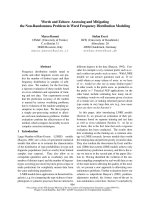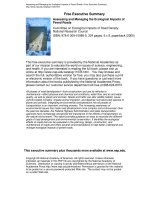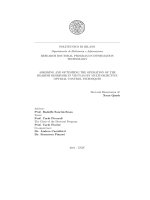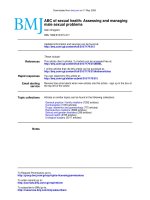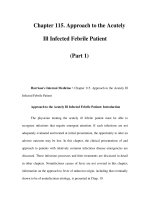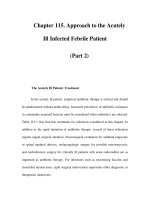Ebook Assessing and managing the acutely ill adult surgical patient: Part 1
Bạn đang xem bản rút gọn của tài liệu. Xem và tải ngay bản đầy đủ của tài liệu tại đây (2.49 MB, 139 trang )
Assessing and Managing the Acutely Ill
Adult Surgical Patient
Edited by
Fiona J McArthur-Rouse MSc, BSc (Hons), Cert Ed, RGN,
Principal Lecturer, Department of Adult Nursing Studies,
Canterbury Christ Church University
Sylvia Prosser PhD, MSc, BEd (Hons), formerly Principal
Lecturer, Department of Adult Nursing Studies, Canterbury
Christ Church University
Assessing and Managing the Acutely Ill
Adult Surgical Patient
Edited by
Fiona J McArthur-Rouse MSc, BSc (Hons), Cert Ed, RGN,
Principal Lecturer, Department of Adult Nursing Studies,
Canterbury Christ Church University
Sylvia Prosser PhD, MSc, BEd (Hons), formerly Principal
Lecturer, Department of Adult Nursing Studies, Canterbury
Christ Church University
© 2007 by Blackwell Publishing Ltd
Editorial offices:
Blackwell Publishing Ltd, 9600 Garsington Road, Oxford OX4 2DQ, UK
Tel: +44 (0) 1865 776868
Blackwell Publishing Inc., 350 Main Street, Malden, MA 02148-5020, USA
Tel: +1 781 388 8250
Blackwell Science Asia Pty Ltd, 550 Swanston Street, Carlton, Victoria 3053, Australia
Tel: +61 (0)3 8359 1011
The right of the Authors to be identified as the Authors of this Work has been asserted in accordance with
the Copyright, Designs and Patents Act 1988.
All rights reserved. No part of this publication may be reproduced, stored in a retrieval system, or transmitted,
in any form or by any means, electronic, mechanical, photocopying, recording or otherwise, except as permitted
by the UK Copyright, Designs and Patents Act 1988, without the prior permission of the publisher.
First published 2007
ISBN 9781405133050
Library of Congress Cataloging-in-Publication Data
Assessing and managing the acutely ill adult surgical patient / edited by Fiona J. McArthur-Rouse, Sylvia Prosser.
p. ; cm.
Includes bibliographical references and index.
ISBN-13: 978-1-4051-3305-0 (pbk. : alk. paper)
ISBN-10: 1-4051-3305-8 (pbk. : alk. paper)
1. Surgical emergencies. 2. Preoperative care. 3. Postoperative care.
4. Surgical nursing. I. McArthur-Rouse, Fiona J. II. Prosser, Sylvia.
[DNLM: 1. Perioperative Care – Nurses’ Instruction.
2. Acute Disease – therapy – Nurses’ Instruction.
3. Adult. 4. Nursing Assessment – Nurses’ Instruction.
5. Surgical Procedures, Operative – Nurses’ Instruction. WO 178 A846 2007]
RD93.A85 2007
617′.919adc22
2006101283
A catalogue record for this title is available from the British Library
Set in 9.5/11.5pt Palatino
by Graphicraft Limited, Hong Kong
Printed and bound in Singapore
by Markono Print Media Pte Ltd
The publisher’s policy is to use permanent paper from mills that operate a sustainable forestry policy,
and which has been manufactured from pulp processed using acid-free and elementary chlorine-free practices.
Furthermore, the publisher ensures that the text paper and cover board used have met acceptable
environmental accreditation standards.
For further information on Blackwell Publishing, visit our website:
www.blackwellpublishing.com
Contents
Preface
Contributors
Acknowledgements
Part 1 Principles of Caring for Acute
Surgical Patients
1. Pre-operative Assessment and
Preparation
Curie Scott, Fiona J McArthur-Rouse,
Jane McLean
Introduction
Pre-operative assessment
Pre-operative preparation
2. The Peri-operative Phase
Luke Ewart and Sandra Huntington
Introduction
The peri-operative environment
Patient admission to the operating department
Physiological monitoring of the surgical
patient
The triad of anaesthesia
Airway management of the anaesthetised
patient
Transfer and positioning of the patient
Peri-operative fluid management
Peri-operative temperature management
Immediate post-operative care
vii
ix
xi
1
3
3
3
10
17
17
17
20
20
21
27
29
32
34
35
3. Post-operative Recovery
Sylvia Prosser and Fiona J McArthur-Rouse
Introduction
The respiratory system
The cardiovascular system
Fluid and electrolyte balance
Nutrition
Elimination
Thermoregulation
Nervous system function
Tissue integrity
4. Post-operative Pain Management
Jane McLean, Sandra Huntington, Fiona J
McArthur-Rouse
Introduction
Types of pain
The physiology of pain
Psychosocial aspects of pain
Adverse effects of unrelieved pain
Assessment of pain
Pharmacological approaches to post-operative
pain management
Non-pharmacological approaches to
post-operative pain management
39
39
40
43
47
50
51
52
53
54
61
61
61
62
66
66
67
69
73
5. Psychosocial Aspects of Surgery
Fiona J McArthur-Rouse and Tim Collins
77
Introduction
Anxiety and stress in the surgical patient
77
77
iv
Contents
Body image
Sexuality
Caring for the dying patient in an acute
surgical environment
Part 2 Surgical Specialities
6. Head and Neck Surgery
Tracey Sharpe and Carma Harnett
Introduction
Tracheotomy and tracheostomy
Neoplastic disease of the head and neck
Laryngectomy
Surgery of the thyroid gland
Other endocrine conditions
7. Vascular Surgery
Ann M Price
Introduction
Common vascular pathophysiological
conditions
Investigations and assessment of vascular
disease
Management of abdominal aortic aneurysms
Thoracic aneurysm
Varicose veins
Peripheral vascular disease in limbs
Arterial insufficiency leading to amputation
Carotid endarterectomy
Conclusion
8. Upper Gastrointestinal Surgery
Ian Felstead
79
82
83
150
151
152
154
89
91
91
91
97
98
99
103
107
107
107
110
112
116
116
117
118
119
120
125
Introduction
Oesophageal disorders
Gastric disorders
Gallbladder disorders
Acute pancreatitis
Pancreatic cancer
125
125
133
135
137
140
9. Surgery of the Lower
Gastrointestinal Tract
Ian Felstead
145
Introduction
Applied pathophysiology of colorectal
disorders
Investigations and diagnosis of colorectal
disorders
Conservative management of GI
obstruction
Pre-operative assessment, monitoring
and preparation for bowel surgery
Major surgical procedures
Post-operative management and care
145
146
148
10. Urological Surgery
Ian Felstead and Jane McLean
Introduction
Urological investigations and diagnosis
Urinary stone disease
Prostate obstruction
Carcinoma of the bladder
Renal cancer
11. Women’s Health
Fiona J McArthur-Rouse
Introduction
Endometriosis
Uterine fibroids (fibromyomata,
leiomyomas)
Genital prolapse
Genuine stress incontinence
Ectopic pregnancy
Gynaecological malignancies
Invasive carcinoma of the uterine cervix
Ovarian cysts and neoplasms
Endometrial cancer
Vulval cancer
Breast cancer
12. Orthopaedic Surgery
Ann Newman
Introduction
Osteoarthritis
Rheumatoid arthritis
Joint replacement surgery
Low back pain
Fractures
Other considerations
13. Identifying and Managing
Life-threatening Situations
Tim Collins and Catherine I Plowright
Introduction
Early warning signs and symptoms of
critical illness
Critical care outreach
157
157
157
162
164
166
174
177
177
177
178
180
181
181
185
185
188
192
195
196
201
201
201
204
208
210
213
223
227
227
227
228
Contents
Systematic assessment of the acutely
unwell patient
Clinical shock
The hypoxic patient
The hypotensive patient
The oliguric patient
228
229
233
236
237
Management of a patient with reduced
consciousness
Cardiorespiratory arrest
Self-test Answers
Index
v
239
240
248
255
Preface
The aim of this book is to provide a source of information for adult nursing and operating department
practitioner (ODP) students and newly qualified
nurses working in acute surgical environments.
The focus is on major surgical conditions and interventions that are commonly encountered in district general hospitals. Increasingly, patients being
nursed in acute wards have complex health care
needs and require intensive observation and monitoring. Reasons for this include the fact that technological developments have led to an increase in the
number of procedures that are carried out on a day
surgical or outpatient basis and a shorter length of
stay for patients undergoing inpatient procedures.
Thus, patients cared for in acute surgical wards are
often older, undergoing major surgical procedures,
or are acutely ill (McArthur-Rouse, 2001). Additionally, advancements in anaesthetic and critical
care techniques have enabled higher risk patients to
undergo major surgical procedures that previously
would have been inappropriate. The net effect of
these occurrences is an increase in the acuity and
dependency of patients being cared for in acute
general wards (Coad & Haines, 1999; DoH, 2005).
Traditionally nurses have not been well
equipped to assess and manage these patients,
missing early warning signs of deterioration, leading to the phenomenon that has become known as
‘sub-optimal care’. McQuillan et al. (1998) describe
sub-optimal care as avoidable components that
contribute to physiological deterioration, with major
consequences on morbidity, mortality, requirement for intensive care and cost. Several strategies
for reducing the occurrence of sub-optimal care
have been implemented including the Critical Care
Outreach Initiative (DoH, 2000, 2005) and the use
of early warning scoring systems. Additionally,
courses have been developed to enable qualified
nurses to recognise the early warning signs of critical illness and caring for highly dependent patients
in the ward environment and such topics are now
addressed in the pre-registration nursing curriculum. This book aims to complement these initiatives with the focus on surgical care. It does not
seek to address every surgical intervention; rather
it focuses on the common major surgical conditions
that could potentially require intensive monitoring
and intervention. It seeks to support the use of
early warning scoring systems by emphasising the
importance of thorough assessment and interpretation of clinical data, thus providing underpinning knowledge to help nurses make sense of
their findings and articulate them effectively to the
appropriate personnel.
The book is divided into two sections. Part One
deals with the principles of surgical care such as
pre-operative assessment and preparation, the
peri-operative period and post-operative recovery.
Additionally the principles of post-operative pain
management are considered, as are the psychosocial
viii
Preface
aspects of surgery. This section deals with the
general aspects of surgical care as they apply to all
patients undergoing surgery and provides underpinning knowledge and rationale for practice.
Part Two considers specific surgical conditions
and interventions and the application of the principles to particular client groups. The chapters in
Part Two are set out according to surgical specialities and each considers the pathophysiology, investigation and diagnosis, assessment, monitoring
and management of common acute surgical conditions cross-referenced to Part One.
Nursing and ODP students should find this book
useful to consolidate what they learn in lectures
and as a guide whilst on surgical placements.
Qualified nurses may also benefit from the book to
enhance their knowledge and understanding of the
rationale for care.
Fiona J McArthur-Rouse and Sylvia Prosser
References
Coad S & Haines S (1999) ‘Supporting staff caring for
critically ill patients in acute care areas’ Nursing in
Critical Care 4(5): 245–248
Department of Health (2000) Comprehensive Critical Care –
A review of adult critical care services. London: DoH
Department of Health (2005) Quality Critical Care – beyond
‘Comprehensive Critical Care’. London: DoH
McArthur-Rouse FJ (2001) ‘Critical care outreach services
and early warning scoring systems: a review of the literature’ Journal of Advanced Nursing 36(5): 696–704
McQuillan P, Pilkington S, Allan A, Taylor B, Short A,
Morgan G, Nielson M, Barrett D & Smith G (1998)
‘Confidential inquiry into quality of care before admission to intensive care’ British Medical Journal 316:
1853–1858
Contributors
Editors
Fiona J McArthur-Rouse, MSc, BSc (Hons), Cert
Ed, RGN, Principal Lecturer, Department of
Adult Nursing Studies, Canterbury Christ
Church University
Sylvia Prosser, PhD, MSc, BEd (Hons), formerly
Principal Lecturer, Department of Adult Nursing
Studies, Canterbury Christ Church University
Authors
Tim Collins, BSc (Hons) Acute Care Nursing,
PGCLT (HE), Dip HE (Nursing), ENB 100, UK
Resuscitation Council Instructor, RN, Senior
Lecturer/Practitioner in Critical Care, Department of Adult Nursing Studies, Canterbury
Christ Church University
Luke Ewart, BSc (Hons), PGCE, RODP, Senior
Lecturer, Department of Adult Nursing Studies,
Canterbury Christ Church University
Ian Felstead, BSc (Hons) Nursing, PGCLT (HE),
DipHE (Nursing), RN, Senior Lecturer in Acute
Care, Department of Adult Nursing Studies,
Canterbury Christ Church University
Carma Harnett, Dip Ear Care, RGN, ENT Nurse
Practitioner, Medway NHS Trust
Sandra Huntington, MSc, Cert Ed, RODP, Senior
Lecturer, Department of Adult Nursing Studies,
Canterbury Christ Church University
Jane McLean, BSc (Hons), Dip Nurse Education,
RGN, RCNT, Senior Lecturer, Department of
Adult Nursing Studies, Canterbury Christ
Church University
Ann Newman, BSc (Hons), PGCLT (HE), RGN
Senior Lecturer, Department of Adult Nursing
Studies, Canterbury Christ Church University
Catherine I Plowright, RN MSc, BSc (Hons)
(Nursing), ENB100, DMS, Consultant Nurse
Critical Care, Medway NHS Trust
Ann M Price, MSc, PGCE, BSc (Hons), RN, Senior
Lecturer, Department of Adult Nursing Studies,
Canterbury Christ Church University
Curie Scott, MBBS, BSc, PGCLT (HE), Senior
Lecturer, Department of Adult Nursing Studies,
Canterbury Christ Church University
Tracey Sharpe, BSc (Hons), RGN, Modern Matron
for Head and Neck Services, Medway NHS
Trust
Acknowledgements
This book has been the result of collaboration
between the authors who would also like to
acknowledge with thanks the additional contributions of:
The Operating Theatre Department, William
Harvey Hospital, East Kent Hospitals NHS Trust
for departmental photographs
Karen E Lumsden, Lecturer Practitioner (Emergency Care), Department of Adult Nursing Studies,
Canterbury Christ Church University, for specialist
subject advice
Rhonda Barnes, Breast Care Nurse Specialist,
William Harvey Hospital, East Kent Hospitals NHS
Trust for specialist subject advice
Angela Harman, Ward Manager, Gynaecology,
Queen Elizabeth the Queen Mother Hospital, East
Kent Hospitals NHS Trust for specialist subject
advice
Yvonne Hill, formerly Head of Department,
Adult Nursing Studies, Canterbury Christ Church
University for her continued support for this
project
Part 1
Principles of Caring for Acute
Surgical Patients
Chapter 1
Pre-operative Assessment and Preparation
Chapter 2 The Peri-operative Phase
Chapter 3 Post-operative Recovery
Chapter 4 Post-operative Pain Management
Chapter 5 Psychosocial Aspects of Surgery
1
Pre-operative Assessment
and Preparation
Curie Scott, Fiona J McArthur-Rouse, Jane McLean
Introduction
This chapter will address the important aspects of
assessing and managing a patient before surgery.
It will be divided into pre-operative assessment
and pre-operative preparation. Box 1.1 identifies
the aims of this chapter.
Pre-operative assessment occurs to screen a
patient for fitness to undergo anaesthetic and
surgery. Formerly, this was conducted by those
with medical qualifications. However, with the aim
of reducing junior doctors’ working hours, other
appropriately trained health professionals, mainly
nurses, have undertaken some tasks that had been
part of the doctors’ remit. The screening and assessment process is increasingly carried out prior to
Box 1.1 Aims of the chapter.
l
l
l
l
To discuss the aims and process of pre-operative
assessment
To enable readers to appreciate the pulmonary,
cardiac and anaesthetic risks relating to surgery
and how these may be assessed
To discuss the pre-operative preparation
undertaken to prevent peri- and post-operative
complications
To identify the limitations of pre-operative
assessment for emergency procedures
admission by a specifically trained pre-assessment
team working to agreed protocols.
A multicentred trial found that appropriately
trained nurses performed pre-assessment of surgical patients comparably with medical staff. Three
essential components were suggested for preparation of nurses taking on these roles:
l
l
l
Masters level modules in anatomy, physical
examination and test ordering
The provision of a clinical mentor (senior
doctor)
A requirement to maintain a learning log-book
as evidence of developing skills (Kinley et al.,
2001)
Although nurses and operating department
practitioners (ODPs) are not qualified to decide
whether a patient is fit for anaesthetic or surgery,
they can identify patients who may be at risk by
using agreed questionnaires (Association of Anaesthetists of Great Britain and Ireland (AAGBI), 2001).
Pre-operative assessment
The aim of pre-operative assessment
Pre-operative assessment is a screening process that
aims to ensure that patients are in the optimum state
before their operation. In addition to evaluating the
4 Caring for Acute Surgical Patients
medical history of the individual and performing
an appropriate physical assessment, there is an
opportunity to enquire about social circumstances,
provide information and allow interventions (such
as referral, counselling, ordering and performing
investigations) if necessary.
Pre-operative assessment commences when the
decision to perform surgery is taken and may take
place in a variety of settings and time spans. In
addition to the patient’s health status, the nature
of surgery will dictate whether it could be accomplished in day surgery or whether the patient
needs to be admitted as an inpatient. Pre-operative
assessment is often conducted at a specified clinic,
but screening may begin at the surgical outpatient
department by patients completing a questionnaire, or via telephone interview (AAGBI, 2001).
These preliminary questionnaires are not a substitute to formal pre-operative assessment, but
enable a reduction in the time spent asking the
basic questions (Garcia-Miguel et al., 2003).
The ideal situation is to have clinics where preoperative assessment occurs in a centralised location near departments where investigations take
place and with access to anaesthetic opinion (Janke
et al., 2002). The timing of a comprehensive preoperative assessment is influenced by the combination of surgical invasiveness and severity of any
existing disease. It needs to be well in advance of
the anticipated day of procedure for all elective
patients (American Society of Anesthesiologists
(ASA), 2002) and the optimum time frame is suggested to be approximately three to four weeks
before surgery (Bramhall, 2002). This permits appropriate adjustment and allocation of staffing and
resources. Additionally, it avoids surgical delay or
cancellation and allows an opportunity for the
consolidation of information given to the patient
(Ziolkowski & Strzyzewski, 2001).
A pre-operative evaluation includes an interview with the patient (ideally with accessible
medical records), a directed examination, investigations when indicated, and other consultations
when appropriate (ASA, 2002).
Figure 1.1 Determining risk of surgery by considering type of
surgery, co-existing disease and the patient’s physical fitness.
(Reprinted from Perioperative Care, Anaesthesia, Pain
Management and Intensive Care, Avidan M et al., p. 7,
© 2003 with permission from Elsevier)
presence of any co-existing disease. Avidan et al.
(2003) suggest that when assessing a patient for
surgery and anaesthetic, consideration about the
potential benefits of the proposed surgery should
be balanced against the risk to the patient. An evaluation of these components will establish whether
there is negligible, low, intermediate or high risk to
the patient (see Figure 1.1). Those in the low-risk
category and those having low-risk surgery may
not need further evaluation but for those considered to be of intermediate or higher risk, further
testing may be beneficial (Avidan et al., 2003).
Patients’ health status can be determined by a
simple classification scale produced by the American Society of Anesthesiologists (ASA) describing
fitness to undergo an anaesthetic. It is separated
into six levels, which are outlined in Table 1.1. They
range from a normal healthy patient (ASA grade 1)
to a declared brain-dead patient whose organs may
be donated (ASA grade 6).
Surgical evaluation
Risk assessment
The risk of surgery to the patient depends on the
type of procedure (either minor or major) and
the patient’s health status, physical fitness and the
History taking
The initial information collected at pre-operative
assessment includes patient demographics, contact
Pre-operative Assessment and Preparation
Table 1.1 Patient physical status (ASA classification) (2005).
ASA
GradeDescription
P1
P2
P3
P4
A normal healthy patient
A patient with mild systemic disease
A patient with severe systemic disease
A patient with incapacitating systemic
disease that is a constant threat to life
A moribund patient who is not expected to
survive without the operation
A declared brain-dead patient whose organs
are being removed for donor purposes
P5
P6
ASA (2005–06) Manual for Anesthesia Department
Organization and Management with permission of the ASA,
Illinois
www.asahq.org/clinical/physicalstatus.htm
Box 1.2 Specific information collected at
pre-operative assessment.
l
l
l
l
l
Current and past medical history
Surgical history with a focus on anaesthetic risk
factors
Medication and allergies
Appropriate family history
Social issues (home transportation and
environment, designated caretakers, alcohol intake
and smoking habits)
details, details of the procedure and relevant
medical practitioners involved in the patient’s care.
Box 1.2 identifies further specific information that
is collected.
For pre-operative evaluation, the focus of the
history and physical examination is on risk factors
for pulmonary, cardiac and anaesthetic complications (Ziolkowski & Strzyzewski, 2001). If the
patient has any risks that can be adjusted, then
elective surgery can be deferred until his or her
health has been optimised. Other areas such as
specific endocrine diseases (diabetes and thyroid
problems) and neurological conditions (e.g. stroke,
muscle disease, epilepsy) are also queried.
l
l
l
l
l
l
5
Atelectasis (partial or complete collapse of a
lung due to obstruction)
Infection (such as bronchitis and pneumonia)
Prolonged mechanical ventilation
Respiratory failure
Bronchospasm
Exacerbation of underlying chronic lung disease (Garcia-Miguel et al., 2003)
The most important risk factor for respiratory
complications is chronic lung disease, which is
more prevalent in smokers. In addition to increased
airway irritability and the risk of developing
post-operative pneumonia, smoking has a negative effect on cardiac function (Ziolkowski &
Strzyzewski, 2001).
Patients with a cold have an increased risk
of bronchospasm and laryngospasm following
instrumentation of the larynx and pharynx, and
this may be life threatening. Additionally, any postoperative coughing may place strain on sutures.
Therefore, it is important to ascertain whether a
patient has a cold and it is wise to consider delay to
surgery until they have recovered (Avidan et al.,
2003).
In addition to specific respiratory conditions
(such as asthma, emphysema, chronic bronchitis,
tuberculosis or obstructive sleep apnoea) it is useful to evaluate the severity of any breathlessness.
Table 1.2 outlines the further questions that relate
to exercise tolerance, coughs, sputum production
and the use of supplemental oxygen therapy.
Cardiac risk
Anaesthesia causes strain on the heart that should
not affect a healthy person but if a heart is compromised by ischaemia, it may not be able to
withstand the increased demand placed on it by
hypoxia, hypotension, hypertension or dysrhythmia (Ziolkowski & Strzyzewski, 2001). Therefore,
the patient’s current and past cardiac history is
confirmed. They are asked several questions to
ascertain any history of chest pain, arrhythmias
and conditions such as myocardial infarction or
hypertension (see Table 1.2).
Pulmonary risk
Anaesthetic risk
Respiratory complications constitute a large proportion of overall morbidity and mortality postoperatively and are more common than cardiac
complications. They include:
Patients are asked if they have previously had an
anaesthetic and whether they or any family member has had problems with anaesthetics. Loose
teeth, caps, crowns and dentures are noted and
6 Caring for Acute Surgical Patients
Table 1.2 Pulmonary and cardiovascular risks.
Patients are asked screening questions about the following topics that relate to the relevant system:
Respiratory system
l
l
l
l
l
l
l
Cardiovascular system
Asthma, chronic obstructive pulmonary disease (emphysema,
chronic bronchitis) or tuberculosis (TB)
Obstructive sleep apnoea
General breathlessness (dyspnoea), orthopnoea (breathlessness
when lying down), paroxysmal nocturnal dyspnoea (wakening
in the middle of the night with breathlessness)
Details of cough and sputum production
Exercise tolerance
Use of supplemental oxygen therapy
Details of any respiratory attacks
l
l
l
l
l
Hypertension
Chest pain, angina, myocardial infarction
Palpitations, arrhythmias, other cardiac
conduction abnormalities
Heart murmurs, rheumatic fever, valvular
dysfunction
Insertion of a pacemaker
(NHS Modernisation Agency, 2003; Ziolkowski & Strzyzewski, 2001)
patients are informed about the potential risk of
chipping to teeth during laryngoscopy (Avidan
et al., 2003). Conditions affecting airway management, such as restriction of jaw or neck movements,
and states that may impact on the patient’s experience, such as depression and anxiety, are also
identified.
Medication and allergies
Medication that patients are taking needs to be
ascertained and should include prescribed, over
the counter and herbal medications as they may
adversely affect the outcome of the surgery. For
example, warfarin will prolong bleeding time so
it needs to be discontinued before surgery commences, especially if blood loss is expected. Patients
often regard herbal medications as being safe, but
some will have an impact on the surgical procedure
or anaesthesia. For example, bleeding time is
prolonged by garlic, feverfew, ginger and ginkgo
biloba and the sedative effects of anaesthesia are
prolonged by valerian and St John’s Wort (Flanagan,
2001). It is important to ask specifically about the
contraceptive pill, as the patient may not consider
this to be medication although it may impact upon
treatment. It is often useful if patients attend the
clinic with their medications or a list of their drugs
with the times they are taken. Allergies to any
medications or other substances such as plasters,
latex and foods are discussed.
Patients should understand the need to withhold or change some medications before the operation. Often medications can be continued but this
should be discussed with the appropriate medical
practitioner. Details of some drugs that need to be
discontinued or continued are shown in Table 1.3.
Patients may benefit from additional medication
before surgery. These are termed ‘pre-medication’
and include anti-emetics, drugs for pain relief or to
reduce anxiety.
Physical examination
A general examination of the patient can be conducted during the history taking. This enables the
health professional to note the patient’s apparent
state of health, their posture and gait, their skin
colour, any obvious lesions and any signs of distress either from anxiety, breathlessness or pain
(Bickley & Szilaygi, 2003). Box 1.3 identifies some
minimum evaluations suggested by the ASA (2002).
Box 1.3 Minimum pre-operative evaluations
suggested by the ASA (2002).
l
l
l
Baseline observations:
᭺ Height
᭺ Weight
᭺ Body mass index (BMI)
᭺ Temperature
᭺ Blood pressure
᭺ Pulse rate
᭺ Respiratory rate
᭺ Oxygen saturation (SpO2)
An airway assessment
Examination of both the cardiovascular and
respiratory systems
Pre-operative Assessment and Preparation
7
Table 1.3 Details of some medications that should be continued or discontinued prior to surgery.
Discontinue
Cardiovascular
l
Continue or initiate
ACE inhibitors and potassium-sparing
diuretics (morning of surgery)
l
l
Respiratory
l
l
Endocrine
l
Long-acting oral hypoglycaemic drugs –
convert to insulin sliding scale
l
l
l
Neurological and
psychiatric
l
Drugs affecting
coagulation
l
Monoamine oxidase inhibitors (2 weeks)
l
l
l
Warfarin – convert to heparin or lowmolecular weight heparin for major surgery
Oral contraceptive pill and hormone
replacement therapy – stop for several weeks
l
l
Other antihypertensive
Beta blockers and anti-anginals
Oxygen
Asthma medications (pre-operative
nebulisation and steroid cover)
Thyroid replacement
Steroids – additional cover may be required
Insulin – convert to sliding scale
Other psychiatric medications
Anti-epileptics – add benzodiazepine
Continue with all anticoagulants where the
bleeding risk is low
Provide post-operative thrombosis
prophylaxis
(Reprinted from Perioperative Care, Anaesthesia, Pain Management and Intensive Care, Avidan et al., p. 9, © 2003 with
permission from Elsevier)
Box 1.4 Simple tests are used to evaluate the airway.
l
l
l
Thyromental distance: the distance between the
thyroid notch to the top of the jaw with the head
extended should be 6.5 cm or more.
The patient should be able to insert their middle
three fingers vertically into their mouth.
The Mallampati test: the patient is asked to open
their mouth as wide as possible and protrude their
tongue out as far as possible. The extent to which the
faucial pillars, soft palate and uvula are visualised
is then graded from 1 (all visualised) to 4 (not
visualised) and is outlined in Figure 1.2. Clinically,
grade 1 usually predicts an easy intubation and
grade 3 or 4 suggest a difficult intubation.
Airway evaluation
Occasionally, there is difficulty in ventilating
and intubating patients, particularly obstetric and
obese patients. Certain physical characteristics may
increase the risk of problems with airway management. These include protruding upper teeth,
limited mouth opening, a large tongue, tracheal
deviation and immobility of the head, neck and
jaw. The patient’s teeth are assessed and any caps,
crowns, bridges or dentures are noted (Avidan
et al., 2003). Box 1.4 identifies some simple tests
that are used to evaluate the airway and Figure 1.2
Figure 1.2 Mallampati test to evaluate the airway.
The patient is asked to open their mouth as wide as possible
and protrude their tongue out as far as possible. The extent to
which the faucial pillars, soft palate and uvula are visualised
is then classified from 1 (all visualised) to 4 (not visualised).
Class I usually predicts an easy intubation and Class III or IV
suggest a difficult intubation.
(Reproduced from Mallampati et al. (1985) ‘A clinical sign
to predict difficult tracheal intubation: a prospective study’
Canadian Anaesthesiologists’ Journal 32: pp. 429–434 with
permission)
illustrates the various grades of the Mallampati test
(Mallampati et al., 1985).
Respiratory examination
The baseline investigations for the respiratory
system include the respiratory rate and the peripheral haemoglobin oxygen saturation (SpO2) while
breathing room air. The shape of the spine and
chest and any use of accessory muscles are noted
8 Caring for Acute Surgical Patients
and then the chest is more closely evaluated. Movement of the chest with each breath is observed for
equality of symmetry and expansion. The patient
is asked to cough up sputum that may otherwise
be heard on auscultation, then asked to breathe
through their mouth moderately deeply. The
stethoscope is used to listen at the front and the
back of the chest over the lung area. Any added
sounds such as wheezes or crackles are recorded.
Other techniques include palpation and percussion. The trachea is palpated to check if it is central,
and placing hands around the chest wall enables
assessment of whether expansion is equal on both
sides. Percussion is a technique where the clinician’s fingers are used to tap the chest wall in order
to produce an audible vibration to assess the density within the lungs (Cross & Rimmer, 2002). Any
abnormality is noted and the surgeon or anaesthetist may need to be informed.
Cardiovascular examination
The patient’s blood pressure and pulse rate need
to be documented. The radial pulse is used to evaluate the rate and rhythm (regular or irregular).
If the patient has a history of stroke or transient
ischaemic attack (TIA) then they may have narrowed carotid arteries, so a stethoscope is used to
listen for a bruit (a swishing sound that indicates
increased turbulence) and if one is noted, the surgeon or anaesthetist should be notified (Janke et al.,
2002).
A jugular venous pressure ( JVP) is measured if
the patient has a history of heart failure or if they
are breathless. With the patient at 45 degrees, the
highest point of the oscillation in the internal jugular vein is noted from the sternal angle. The JVP is
useful, as the pressure in the jugular vein reflects
right atrial pressure and provides a clinical indicator of cardiac function (Bickley & Szilaygi, 2003).
The chest is then examined for any deformities,
surgical scars, visible pulsations or evidence to
indicate a pacemaker or cardiac defibrillator (a rectangle under the skin). The heart is auscultated by
listening in various regions on the chest wall using
the diaphragm (for high-pitched noises) and the
bell (for low-pitched noises). The first (S1, ‘lub’) and
the second (S2, ‘dub’) heart sounds and any additional sounds, such as murmurs, are recorded.
Finally, any evidence of peripheral oedema and its
extent should be described.
Pre-operative tests and investigations
At pre-operative assessment, patients at high risk
are identified for appropriate testing and interventions to reduce their surgical risk. The ASA (2002)
states that pre-operative tests are useful only if they
affect peri-operative anaesthetic care, and any testing should be informed by the history and examination (Avidan et al., 2003). Investigations in a healthy
patient having minor surgery are unnecessary and
routine tests are not advised. The argument that
they may be useful to discover a disease or disorder
in an asymptomatic patient does not make an
important contribution to pre-operative assessment
(AAGBI, 2001). Specific pre-operative investigations for particular types of surgery are discussed
in the relevant chapters in Part Two of this book.
The UK National Institute for Clinical Excellence
(NICE) published a comprehensive review of evidence on pre-operative testing for elective surgery
(NICE, 2003). The tests relate to the complexity of
the operation and to the ASA grades and are
highlighted in a visual manner as a series of traffic
lights (if red, the test is not recommended; if yellow,
the test can be considered; and if green, the test
is recommended). Their guidance suggests that,
for healthy patients aged 16 – 80-plus undergoing
minor surgery, the only recommended test is an
electrocardiogram (ECG) for those over 80 years
old. Some tests are to be considered across some of
the age-spans (urinalysis, full blood count, renal
function) but generally, tests were not considered
necessary in this group of people.
Appropriate selection of pre-operative investigations is promoted if departments have policies
on which investigations should be performed to
reflect the age, co-morbidity and complexity of the
surgery (AAGBI, 2001). For example, some tests are
useful in certain circumstances and Avidan et al.
(2003) outline the following:
l
l
l
Haemoglobin measurement – before surgery
where major blood loss is anticipated; may be
justified in older people and in menstruating
women or if anaemia is suspected
Platelet count and coagulation (clotting) studies
– if the history raises concerns about abnormal
clotting
Urea, creatinine and electrolytes – if the patient
is dehydrated, has renal dysfunction or if electrolyte abnormalities are suspected
Pre-operative Assessment and Preparation
The AAGBI (2001) suggests that an ECG is not
indicated for asymptomatic males under 40 or
asymptomatic females under 50 but is valuable in
all patients with a cardiac history. Interestingly,
Kinley et al. (2002) found that house officers
ordered almost twice as many unnecessary tests as
nurses. This was possibly due to the fact that nurses
adhered to protocol more than the house officers.
Blood transfusions
Patients who are likely to require a blood transfusion post-operatively will have blood taken for
grouping or cross matching. Although rare, risks
of blood transfusions include the possible transmission of hepatitis, HIV/AIDS virus and variant
Creutzfeldt–Jakob disease (vCJD), as well as transfusion reactions. Patients should be counselled
about the possible need and any objections to
receiving blood products should be documented.
Autologous transfusion reduces the need for
donated blood transfusion and is sometimes used
in elective surgery. Box 1.5 identifies the main
techniques of autologous blood transfusion.
MRSA screening
Most hospitals have policies for screening patients for methicillin-resistant Staphylococcus aureus
(MRSA) because whilst colonisation on the individual’s skin may be harmless, should the bacteria
Box 1.5 Types of autologous blood transfusion.
Pre-operative donation – patients who are otherwise
fit for surgery may donate their own blood, which can
be stored for up to 35–42 days. Contraindications to
autologous transfusion include sepsis and severe
myocardial infarction.
Isovolaemic haemodilution – up to 1.5 litres of blood
may be withdrawn before the induction of anaesthesia
and replaced by intravenous saline infusion. This
results in haemodilution and a reduction in the red
blood cells lost during surgery. The withdrawn blood
can be reinfused either intra- or post-operatively.
Cell salvage – blood is collected from the patient either
by suction directly from the operation site or
via collection devices attached to surgical drains
(see Chapter 12). The blood is reinfused either intraor post-operatively, with or without washing.
(Green & McClelland, 2004)
9
be transferred into the patient’s wound, severe
infection may occur. Also, debilitated patients are
more at risk of contracting an infection. This is particularly relevant for patients undergoing orthopaedic surgery (see Chapter 12). Swabs are usually
taken from the patient’s nose and groin and, if positive, decontamination is recommended according
to local policy.
Pressure sore risk assessment
Surgical patients are at increased risk of developing
pressure sores because of the increased time that
they are immobile during and immediately after
their operation. The Waterlow Risk Assessment
Scale (Waterlow, 1988) is frequently used to assess
the patient’s level of risk and enables staff to implement appropriate plans of care and allocate the necessary pressure-relieving devices. In older patients
and those at increased risk of developing pressure
sores it is important to inspect, assess and document the status of the pressure areas on admission.
Nutritional screening and assessment
In an important study undertaken in the early
1990s, McWhirter and Pennington (1994) highlighted that many patients are admitted to acute
hospitals in a nutritionally compromised state.
Additionally, during hospitalisation, further deterioration in their nutritional status can occur.
Surgical patients are at particular risk of developing malnutrition, due in part to the nature of the
surgery and any pre-existing disease, and also to
factors such as prolonged fasting pre-operatively
and restriction of oral intake post-operatively.
Older people in particular may have preexisting poor general physical and mental health
causing a loss of appetite. Chronic ill health and
acute episodes of illness are often associated with
an impaired appetite, as are depression and drug
treatments such as chemotherapy. Patients who
have difficulty swallowing or who are fasting
for surgery or other tests may miss meals. If an
operation is cancelled, the fasting period may be
prolonged if pre-operative nutritional support is
not instigated.
During nutritional screening, patients at risk
of malnutrition who may require a more comprehensive nutritional assessment are identified.
10
Caring for Acute Surgical Patients
Box 1.6 Nutritional screening – observations and questions that may be asked when taking a dietary history.
l
l
l
l
l
l
l
Age – older patients are at increased risk of
malnutrition
History of recent unintentional weight loss – how much
weight has been lost? How quickly? Do the patient’s
clothes appear to be loose? Body mass index.
Appetite – does the patient finish meals or leave all
or part of each meal? Are meals skipped?
Physical ability to prepare meals and eat – does the
patient require assistance with the preparation of meals
and/or with eating? Is a particular diet required? What
is the condition of the patient’s mouth and teeth?
Gastrointestinal function – does the patient suffer from
constipation or diarrhoea, indigestion, heartburn, or
nausea and vomiting?
Social factors – does the patient eat alone or with
family? Who shops and which products are bought?
How much exercise does the patient have?
Medical factors – does the patient have any pre-existing
diseases that may influence nutritional intake and
demand (e.g. diabetes, thyroid disease, malignancy,
Nutritional screening involves taking a dietary and
clinical history from the patient (see Box 1.6). If
nutritional screening highlights a deficit, further
assessment may be undertaken, usually by a dietician. This will include more intense measurements,
such as anthropometric indices and biochemical
indicators (see Edwards (2000) for further discussion of these). If a nutritional deficit is identified, it
is important to instigate pre-operative nutritional
support in order to optimise the patient’s condition
pre-operatively. This may take the form of dietary
supplements, enteral or parenteral feeds. (See
Chapter 3 for a further discussion of the nutritional
demands of surgery.)
Assessment of home circumstances
In order to prevent delays in discharging the
patient post-operatively, an assessment of the individual’s home circumstances and support mechanisms should take place pre-operatively, preferably
as part of the pre-admission assessment. This
includes providing the patient with an anticipated
date of discharge and, if long-term convalescence
is likely to be required, commencing the necessary
arrangements, including any specialist referrals
l
l
food allergies)? Is the patient taking any medication that
may influence appetite?
Psychological factors – does the patient appear
depressed? Has he or she suffered a recent
bereavement?
General appearance – the following should be
observed:
᭺ Skin – tone, texture, colour, signs of bruising
᭺ Nails – white patches, dry, brittle
᭺ Eyes – colour and condition, sunken
᭺ Mouth – moist, pink mucosa or discoloured
᭺ Lips – are they dry and cracked?
᭺ Tongue – is it dry or moist, clean or furred?
Does the breath smell?
᭺ Gums – do they bleed for no reason? Do they
recede?
᭺ Dentures – do they fit?
᭺ Cheek bones – are they overly prominent?
᭺ Clothes and rings – are they loose?
(e.g. social work, occupational therapist). Any
changes that need to be made to existing care packages should also be noted.
Pre-operative preparation
Preparing patients for surgery involves both psychosocial and physical dimensions. Psychosocial
preparation includes assessing and managing
anxiety and stress, patient education and informed
consent, whilst physical preparation is concerned
with the prevention of peri- and post-operative
complications.
Psychosocial preparation
This aspect of pre-operative preparation often commences when the patient visits the pre-assessment
clinic. Sometimes they have the opportunity to visit
the ward or intensive care unit and meet the staff
who will be caring for them. Alternatively, theatre
staff may come to the ward once the patient has
been admitted, to introduce themselves and answer
any questions the patient may have. Chapter 5

